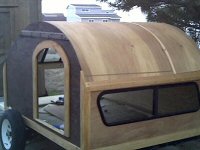please do not let this turn into an arguement. this post is for awareness. if you are going to post, keep it on topic.
i am not a technical person, so i will not (me personally) even begin to discuss reasons why, how or whatever. i will leave that to others.
i know there is some debate as to what works, doesn't work, what could be improvd upon etc.
the tb2/3 coated foam, convered with canvas, does work. its been proven. now for how long, well only time will tell. could improvements be made, i am sure the answer is yes.
some things i have read, deal with the issues of glues vs epoxy. if you use canvas, there are the issues of fraying ends of the cut material. its just a given when using material. however, once glued down, its not coming up or off, on its own. i would have to work to pry my ends up and off. left up to nature, well so far, so good. again for how long, only time will tell. but, does it work, yes it does. gpw, also found a way of getting less fraying, he used pinking shears. i remember reading someone else saying they glued canvas first and then cut, making for less fraying.
water proof issues. i have zero issues with water. i can tell you the only place water is going to come into my tear is thru the gaps in my door, or my open window. i have been on about 8 trips this year with it, and at least 6 of the 8 it poured while camping. our first trip out, buckets of water was poured onto my hatch area, i ended up with only a couple drops of water that came in thru the "un"treated canvas. so is it water proof? yes it is. my hatch area has been completely treated now, so i haven't had any water issues back there since.
as most of us know, my foamie developed bubbles/delamination/blisters, what ever word you want to use. a couple of us guess this is because of the cinch straps i use, compressing the foam. others, have different thoughts of the cause. i just spoke via chat with dave, the blue bonnet builder. in case you are not aware, he built the first foamie that i know of. he used the pink foam, he used good ole gorilla glue, but he used epoxy vs what i used tb2. a very interesting thing came out of that conversation. he has blistering. he did tell me once he repaired the spot, so far it hasn't come back. i have not tried to repair my bubbles yet, so i can't comment on that part.
what i find interesting here, is that even using epoxy, there was blistering/bubbling.
we have mentioned this before in one of our threads about using a perferation(sp?) type tool. dave said, if he were to do again, that is one of the improvements he would make. we need to work on getting whatever adhesive/coating we are going to use, into that foam. "root" system so to speak (mentioned here somewhere).
my point being, one glued foamie has blisters, and one epoxy foamie has blisters. we all can speculate on the causes. dave's epoxy foamie has been camping for 3 yrs now also. my glued foamie only 1 yr.
so i don't know what else to say about this right now. i will leave it up for discussion. remember to keep it clean, and i will not allow an arguement to start.
i wished mikes was further into the build so we would have more experience with primer vs glue vs epoxy.
glue vs epoxy
Moderator: eaglesdare
45 posts
• Page 1 of 3 • 1, 2, 3
glue vs epoxy
Louella
May the foam be with you.
May the foam be with you.
-

eaglesdare - Donating Member
- Posts: 3168
- Images: 13
- Joined: Tue Aug 26, 2008 7:06 pm
Louella
I have seen blisters on fiberglass sailboats the cause I was told was moisture
being trapped when the fiberglass was being laid over the gel coat
I have read about the filon (sic) sided travel trailers having de-lamination
I have built or help build two all fiberglass airplanes I have never heard about any of the hundreds of the same type having blisters.
the idea of using a device to poke small holes into the foam to allow the TB to penetrate into the foam and form a better bond sounds like a good idea.
If one wants a light weight trailer foam sounds like the way to go
whatever one chooses to use to apply the canvas be it TB or epoxy or paint all seem to work.
like you said time will tell what works and what doesn't what is easy to fix and what is just a big PITA.
I have seen blisters on fiberglass sailboats the cause I was told was moisture
being trapped when the fiberglass was being laid over the gel coat
I have read about the filon (sic) sided travel trailers having de-lamination
I have built or help build two all fiberglass airplanes I have never heard about any of the hundreds of the same type having blisters.
the idea of using a device to poke small holes into the foam to allow the TB to penetrate into the foam and form a better bond sounds like a good idea.
If one wants a light weight trailer foam sounds like the way to go
whatever one chooses to use to apply the canvas be it TB or epoxy or paint all seem to work.
like you said time will tell what works and what doesn't what is easy to fix and what is just a big PITA.

-

pete42 - Super Lifetime Member
- Posts: 2203
- Images: 13
- Joined: Sat Nov 07, 2009 11:52 am
- Location: SouthWest Ohio






 Cheap usually ... Don’t stick yourself ...
Cheap usually ... Don’t stick yourself ...
